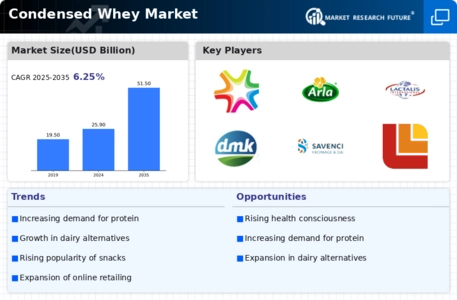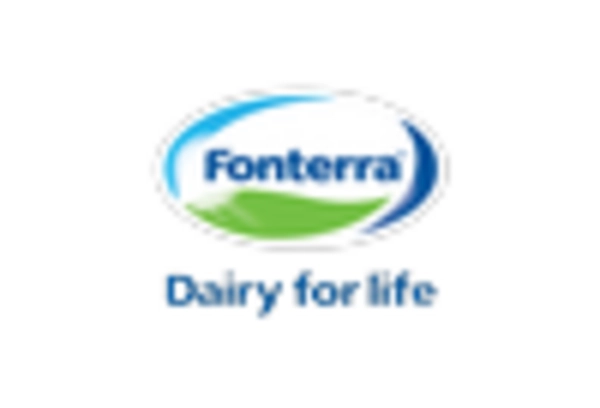Expansion of Dairy-Based Products
The Condensed Whey Market is experiencing growth due to the expansion of dairy-based products. As consumers increasingly favor dairy for its nutritional benefits, manufacturers are innovating to create a variety of products that incorporate condensed whey. This includes protein bars, beverages, and baked goods, which are gaining traction in the market. The dairy sector has shown resilience, with reports indicating a steady increase in dairy consumption. This trend suggests that the demand for condensed whey, as a versatile ingredient, will continue to rise, thereby enhancing the overall market landscape. The ability of condensed whey to enhance flavor and texture in various applications further solidifies its position in the Condensed Whey Market.
Growth in Sports Nutrition Sector
The burgeoning sports nutrition sector is a pivotal driver for the Condensed Whey Market. With an increasing number of individuals engaging in sports and fitness activities, the demand for nutritional supplements, particularly those containing whey protein, is on the rise. Market analysis indicates that the sports nutrition segment is expected to witness substantial growth, with whey protein products being favored for their efficacy in muscle recovery and performance enhancement. This trend is likely to propel the Condensed Whey Market forward, as brands strive to develop innovative formulations that meet the specific needs of athletes and active individuals. The alignment of product offerings with consumer preferences in this sector is crucial for market success.
Rising Demand for Protein-Rich Foods
The increasing consumer inclination towards protein-rich diets is a notable driver in the Condensed Whey Market. As health consciousness rises, individuals are seeking high-protein food options to support muscle growth and overall wellness. This trend is particularly evident among fitness enthusiasts and athletes, who often incorporate whey protein into their diets. According to recent data, the protein supplement market is projected to grow significantly, with whey protein accounting for a substantial share. This surge in demand for protein-rich products is likely to bolster the Condensed Whey Market, as manufacturers respond by innovating and expanding their product lines to cater to this health-oriented consumer base.
Emergence of Plant-Based Alternatives
The emergence of plant-based alternatives presents both challenges and opportunities for the Condensed Whey Market. As consumers increasingly explore vegan and plant-based diets, there is a growing demand for non-dairy protein sources. However, this trend also encourages innovation within the condensed whey sector, as manufacturers may seek to blend whey with plant-based proteins to create hybrid products. This strategy could appeal to a broader audience, including those who are lactose intolerant or prefer plant-based options. The ability to adapt to changing consumer preferences may enhance the resilience of the Condensed Whey Market, allowing it to coexist alongside the rising popularity of plant-based diets.
Technological Advancements in Processing
Technological advancements in processing techniques are significantly influencing the Condensed Whey Market. Innovations in production methods, such as membrane filtration and spray drying, have improved the efficiency and quality of condensed whey products. These advancements not only enhance the nutritional profile of whey but also extend its shelf life, making it more appealing to manufacturers and consumers alike. As processing technologies continue to evolve, the Condensed Whey Market is likely to benefit from increased product availability and variety. Enhanced processing capabilities may also lead to cost reductions, allowing for competitive pricing in a market that is becoming increasingly dynamic and diverse.


















Leave a Comment